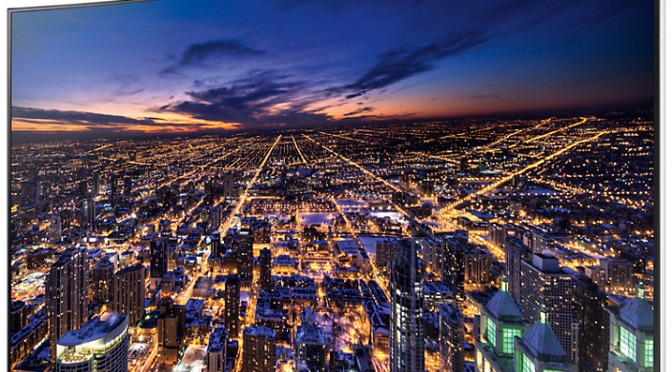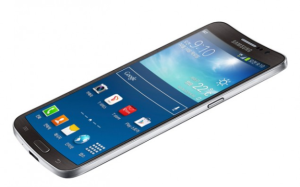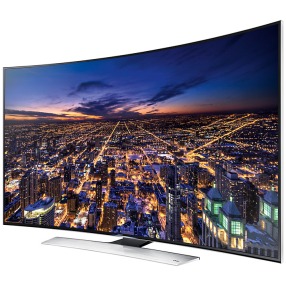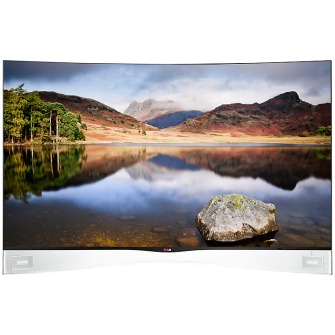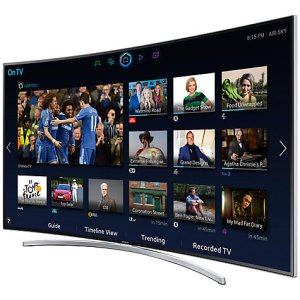Just what exactly is the crack with curved screen TVs? Does having a curved screen really enhance you viewing experience or is it just a massive waste money? LG and Samsung are the current market leaders when it comes to curved screen technology and both currently have a range of curved TVs available to consumers. Both companies are adamant that curved screens represent the future of home entertainment and it would seem that the technology is here to stay. The question is then; just how good is the technology and does it actually enhance your viewing experience?
Background.
The first curved TV prototypes were only introduced to the world last year at the Consumer Electronic Show (CES) 2013 and within only a year we have already seen the technology develop, with both Samsung and LG showcasing their latest range of curved TVs at the CES 2014 earlier this year.
Although curved screen technology has been around for many years, It was actually Samsung who initially wowed the world when in 2010 it announced it was developing the worlds first curved screen Smartphone. Passionate about this technology they were quick to push through a prototype of the device which was showcased at the 2011 CES. Although this brought questionable benefits to the smartphone, it showed the world what the technology was capable of and got people talking. By the end of 2013 the worlds first curved screen smartphone was unleashed on the world. The Samsung Galaxy Round was born.
When LG and Samsung announced their prototype curved TVs at the 2013 CES they both claimed to be the first to the market. LG however arguably had a slight advantage in that their curved screen supported 3D technology and they actually started taking orders at the show.
This year at the CES 2014 Samsung showcased what it claimed to be the worlds largest Ultra High Definition (UHD) curved screen TV – a 105 inch behemoth. For those of you not familiar with UHD, this is the latest Ultra Hight Definition format and is more commonly known as 4K. 4K is 4 times the resolution of full HD and as such is blisteringly sharp.
Of course LG weren’t to be overshadowed by Samsung and similarly boasted about their own record breaking TV. This was slated as being the worlds first and largest curved OLED UHD TV with a screen size of 77 inches. OLED stands for organic light emitting diode and basically means that each pixel is capable of producing its own light source. This does away with bulky internal lighting and makes for a much thinner and lighter display.
Although the technology is still in its infancy, within just a year we have seen some massive technological developments and some equally impressive price reductions. Both Samsung and LG are championing the technology and are passionate about the benefits it brings.
Why curved screen TV’s are awesome.
Now I don’t want to baffle you with science but an apparent major benefit to viewing a curved screen is concerned with what is known as the ‘sweet spot’. There is always an optimum position when watching TV and at the cinema the screen is so large that this isn’t really an issue. Many people can sit within the sweet spot and still get the optimum viewing experience. Gizmodo point out however that” the sweet spot in you’re living room covers one, maybe two people at most. This means that the best place to watch is from direct centre, with the middle of the screen at eye height”.
The reason for this is because the middle of the screen is closest to the viewer. As we move away from the centre and towards the edges there is a very slight distortion in the colours and image. This is due to the edges of the TV being further away and is more noticeable on larger screens with the viewer sitting further away. By adding even a slight curve to the screen this brings the edges further towards the viewer and thus reduces distortion. This, and the fact that the screen follows the curvature of the eye, makes for a more natural viewing experience. Viewing angles are also better as a result.
It is also noted that the wrap around nature of the screen makes for a more inclusive and immersive experience.
According to LG the curvature also creates a slight magnified effect, making the the screen appear larger and brighter than on a standard TV. The picture is brighter due to the light emitting from the display being more focused towards the audience.
There is also the wow factor associated with curved screen TVs. They have not yet become commonplace in peoples homes and by owning one you really will be the envy of all your mates. For someone such as myself who loves the latest and greatest tech the curved screen TV really is the thing of the future. Sometimes I buy things just because they wow me.
Things to consider.
Price should be a serious consideration when thinking about a curved screen TV. Whilst prices have reduced drastically in a short period of time, curved TVs are still more expensive than standard TVs. As mentioned prices on the high street range from about £2000 to £4000. That said I really must stress how much more affordable these TVs are compared to just a year ago. For example in 2013 it would have cost around £25000 to purchase a UHD curved screen TV. Today you can purchase one for as little as £4000. I say “as little as £4000” not because I could afford one, but rather because of how much more affordable the technology has become.
Another potential problem is that curved screen TVs are not exactly easy to mount on the wall. Whilst mounting solutions have now become available, they are not exactly cheap or readily available. Curved screen TV’s are really designed to be free standing, and to be honest do you really want one protruding from you’re living room wall?
Size is another issue that needs considering with 55 inches being pretty much the smallest size available. For a lot of people this will just be too big, particularly if you have a smaller sized room. The size also adds to the issue of mounting.
Lastly, the technology is still evolving. Whilst LED and OLED technology is nothing new, you may be best off waiting a few years to get the best spec and the best price. At the moment OLED technology is very new to curved screen TVs and is only offered by LG. OLED TV screens are mesmerisingly thin and are clearly going to become more readily available. At the minute however you will have to choose between OLED technology and UHD (4K).
To be honest, you will get the more out of OLED technology at present than you will UHD. This is due to there being very few 4K sources. That said, Netflix will soon be streaming in 4K and this will look undoubtedly beautiful on your UHD TV screen. However, when spending this much money on a TV you will want a certain level of future proofing. Thats why I would suggest waiting until OLED and UHD come hand it hand and at a reasonable price.
So should I invest in one?
When Samsung released the Galaxy Round smartphone I fought it was a huge gimmick. I just couldn’t, and still can’t see the benefit of having a curved screen on a smartphone. It makes no difference at all to the viewing experience and just makes it really difficult to fit the device in your pocket. Im not sure Samsung released the Galaxy Round for any reason other than showing off the curved screen technology. Basically they put a curved screen on a smartphone because they could. This was the beginnings of the curved screen revolution and Samsung wanted to show the world what they were capable of.
Curved screen TVs are different, however. The technology has a practical implication and in my opinion enhances the viewing experience. I have to say that whilst I was still a little pessimistic about the concept of having a curved screen TV, I am now completely won over. Having viewed many different models I am absolutely mesmerised by how impressive these products are.
Even on the entry level Samsung 8000 series TV – with its mere 1080p resolution — the image quality is stunning. The 55 inch version retails at less that two grand in the UK and actually represents brilliant value for money. Whilst still more than what most people can afford, we are almost within the realms of affordability.
My opinion is that the technology is here to stay and that we need to embrace it. Whilst still a little expensive, prices have quickly stabilised and will continue to do so. My concern is that the technology is still young, however. My worry is that I would buy I curved screen TV today and within a year it will be out of date. If i’m spending a lot of money on a new TV I need to know that it will be relevant and current for at least 5 years. If you want my opinion wait a few years and then invest. Who knows, we may find curved screen TVs with UHD and OLED technologies retailing for less than a grand. That really would be great value!
Sources:
Gizmodo, Trusted Reviews, The Independent
